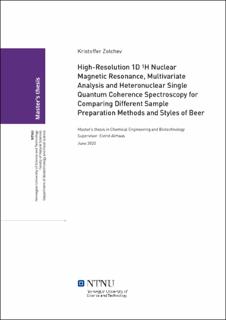| dc.description.abstract | The consumption of beer is deeply embedded in Norwegian history, all the way back to when the vikings celebrated after a day of successful plundering. Worldwide, the variety of different kinds of beers is greatly increasing, with new microbreweries popping up at an impressive rate. Despite the large popularity of beer throughout history, little research has been done on beer using nuclear magnetic resonance (NMR). NMR has previously been used in wines and spirits to gain information on the compounds associated with taste and alcohol content, as well as to ensure product quality. In the present study, we sought to develop a protocol for analysing beer in NMR. The main aim of the study was to see whether there is a difference between the degassing and buffering methods applied to the samples, and which method is most suitable for the creation of a standard NMR protocol. The second aim of this study was to see whether there are any chemical differences between the beer styles that can be detected in NMR. In order to develop such a protocol, we used six different types of beer: stout, IPA, weissbier, lager, sour-stout, and tripel. Each beer was split into twelve samples, of which three were buffered and vortexed, three were buffered and ultrasonicated, three were vortexed and not buffered, and three were ultrasonicated and not buffered. NMR was performed on a Bruker Avance III HD 800 MHz spectrometer, equipped with a 5-mm Z-gradient CP-TCI (H/C/N) cryoprobe at the NV-NMR-Centre/Norwegian NMR Platform at Norwegian University of Science and Technology (NTNU). We performed PCA to compare the different sample preparation methods for each individual beer type. The results showed that the largest difference between buffered and unbuffered samples appears to be their pH, as made evident by the large proportion of variance explained by PC1. PCA did not appear to identify any differences between the degassing methods. The NMR analysis combined with Heteronuclear Single Quantum Coherence (HSQC), revealed that the stout beer had highest intensity peaks related to amino acids, whereas the tripel beer had more than twice the intensity of the other beer styles for the peaks related to lactic acid. For the suggested, but not confirmed, peaks related to histidine, the lager and IPA had the highest intensity, whereas stout had the highest intensity for the peaks related to formic acid. In sum, our results show that buffering beer samples is highly recommended for simplifying the NMR analysis and comparison of the samples. Further, our results demonstrate that NMR analysis can be used to identify compounds associated with alcohol concentration, vicinal diketones, and esters in beer. | |
